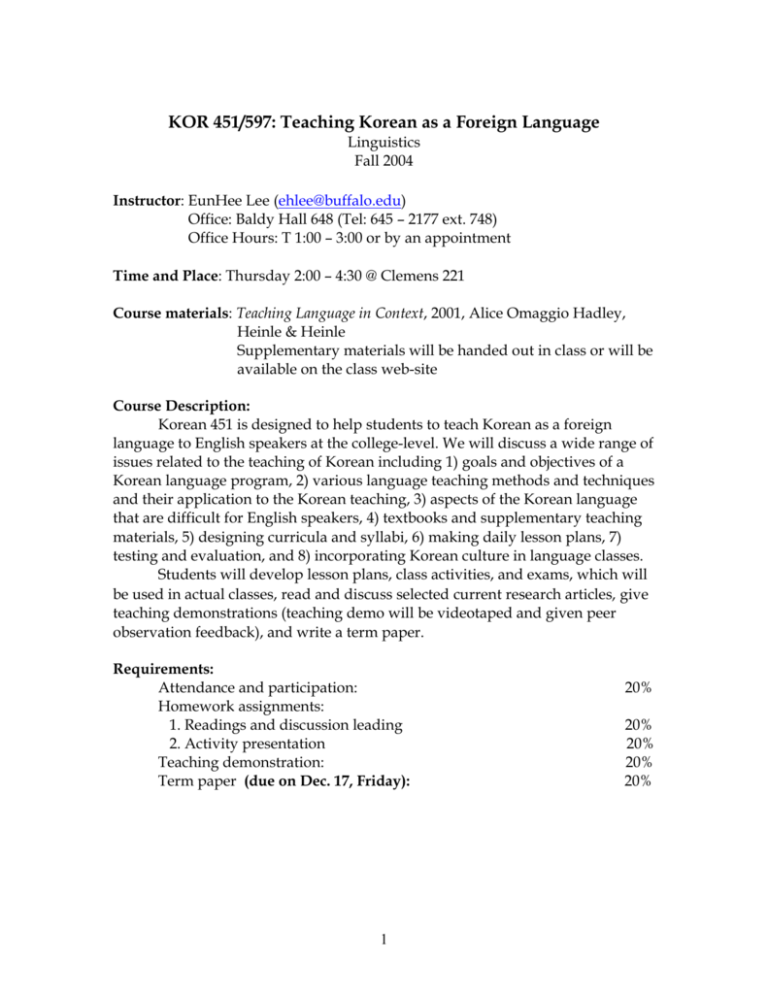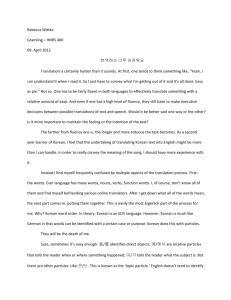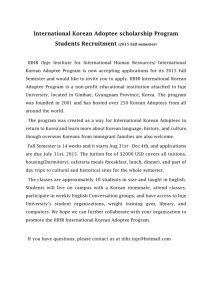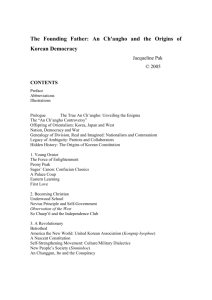Syllabus - Department of Linguistics :: University at Buffalo
advertisement

KOR 451/597: Teaching Korean as a Foreign Language Linguistics Fall 2004 Instructor: EunHee Lee (ehlee@buffalo.edu) Office: Baldy Hall 648 (Tel: 645 – 2177 ext. 748) Office Hours: T 1:00 – 3:00 or by an appointment Time and Place: Thursday 2:00 – 4:30 @ Clemens 221 Course materials: Teaching Language in Context, 2001, Alice Omaggio Hadley, Heinle & Heinle Supplementary materials will be handed out in class or will be available on the class web-site Course Description: Korean 451 is designed to help students to teach Korean as a foreign language to English speakers at the college-level. We will discuss a wide range of issues related to the teaching of Korean including 1) goals and objectives of a Korean language program, 2) various language teaching methods and techniques and their application to the Korean teaching, 3) aspects of the Korean language that are difficult for English speakers, 4) textbooks and supplementary teaching materials, 5) designing curricula and syllabi, 6) making daily lesson plans, 7) testing and evaluation, and 8) incorporating Korean culture in language classes. Students will develop lesson plans, class activities, and exams, which will be used in actual classes, read and discuss selected current research articles, give teaching demonstrations (teaching demo will be videotaped and given peer observation feedback), and write a term paper. Requirements: Attendance and participation: Homework assignments: 1. Readings and discussion leading 2. Activity presentation Teaching demonstration: Term paper (due on Dec. 17, Friday): 1 20% 20% 20% 20% 20% Class Schedule: Week: Date: Topic: Assignment: #1 Sep. 2 Introduction #2 Sep. 9 Curriculum goals and textbooks #3 Sep. 16 Rosh Hashana (No Class) #4 Sep. 23 Teaching methods H.W. 2 #5 Sep. 30 Teaching Korean sounds, alphabet, and basic vocabulary H.W. 3 H.W. 1 #6 Oct. 7 Teaching Korean grammar I H.W. 4 #7 Oct. 14 Teaching Korean grammar II H.W. 5 #8 Oct. 21 Teaching demonstration and feedback I #9 Oct. 28 Teaching listening and speaking in Korean H.W. 6 #10 Nov. 4 Teaching reading and writing in Korean H.W. 7 #11 Nov. 11 Testing and assessment H.W. 8 #12 Nov. 18 Incorporating culture in Korean classes H.W. 9 #13 Nov. 25 Fall Recess (No Class) #14 Dec. 2 Teaching demonstration and feedback II #15 Dec. 9 Term paper presentation 2 Homework Assignments Students are required to read the assigned chapters and articles. Students will take turns for presentation of the reading and material adaptation/creation. HW 1: due 9/9 1. Read ACTFL guidelines for language proficiency and examine whether the description of each level can also apply to Korean. Make a list of objectives for beginning, intermediate and advanced Korean classes in order to achieve the proficiency goal of each level. 2. Check out the website of American Association of Teachers of Korean (www.aatk.org) and find out the types of Korean language programs in the U.S. 3. Read Hadley (2001) Ch. 1 HW 2: due 9/23 1. Read Hadley (2001) Ch. 3 HW 3: due 9/30 1. Choose a chapter from KLEAR or Ehwa textbook and evaluate the material and activities in terms of how well they promote communication skills or increase actual proficiency. 2. Read “Incorporating intonation in Korean language instruction” (2000), Mee-Jeong Park, Proceedings of AATK. pp. 373 – 384, and critically examine the author’s suggested classroom activities. HW 4: due 10/7 1. Make a lesson plan to teach sound/alphabet of Korean. Refer to The Sounds of Korean: A Pronunciation Guide, 2004, Miho Choo and William O’Grady, University of Hawaii Press. 2. Evaluate the vocabulary selection and treatment of a textbook. 3. Read “A corpus-based analysis and teaching of Korean causal connectives: -nulako and –nun palamey” (2004), Sangsuk Oh, AATK, and critically examine the author’s suggested classroom activities. HW 5: due 10/14 1. Choose a grammar pattern from textbooks and adapt to improve the presentation and practice exercises. 2. The current trend to incorporate form-focused activities and explicit grammar instruction. Think about the rationale for such a move. Refer to Input Processing and Grammar Instruction in Second Language Acquisition (1996), VanPatten, B. Ablex Publishing Corp, for ideas. 3. Read “연결 어미의 의미 확장과 한국어 교육” (2003), 정 연희, 한국어 교육을 위한 한국어 문법론, 한국 문화사, pp. 399 – 482. 3 HW 6: due 10/28 1. Choose a pair of grammar patterns (a list of grammar patterns will be handed out) and make a grammar lesson. Use it to teach students and report the result. 2. Read Hadley, Ch. 5 & 6 3. Read “The role of corrective recast in L2 Korean: Object relatives and the honorific morpheme –si -“ (2002), Mijung Lee, AATK. HW 7: due 11/4 1. Choose a topic (e.g., at a market, at the post office, calling a friend, asking for direction, etc) and make a listening comprehension/speaking activity. 2. Read Hadley, Ch. 4 & 7 3. Read “담화 능력 배양을 위한 읽기 교육 방안” (1996), 김 정숙, Korean Language Education vol. 7, pp. 295 – 309, Hankuk Publishing. HW 8: due 11/11 1. Choose a reading from the Ehwa textbook and make a reading lesson. Evaluate writing activities of the Ehwa textbook. 2. Read Hadley, Ch. 9. 3. Read “Assessing levels of proficiency in Korean” (2000), Sahie Kang and Michael Kim, AATK, pp. 211 – 222. HW 9: due 11/18 1. Make an exam of a lesson from KLEAR textbook. Try to incorporate different skill areas as much as possible when you write test items. 2. Read Hadley, Ch. 8. 3. Read “Defining, interpreting, and teaching Korean culture in the 21st century” (1996), Donald Baker, Korean Language Education vol. 7, pp. 143 – 153, Hankuk Publishing. 4





